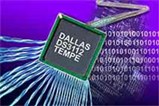T3/E3 Multiplexer

T1 and E1 transmission lines are used throughout the world to transport phone calls and data at the edge of the network. Where higher data rates are needed, T3 and E3 lines are often deployed. A T3 line (44.736 Mbps) aggregates 28 T1 lines (1.544 Mbps) or 21 E1 lines (2.048 Mbps). An E3 line (34.368 Mbps) aggregates 16 E1 lines. The various line aggregations are accomplished with three multiplex configurations, termed M13, G.747, and E13, respectively.
The new multiplexer is used to merge lower-speed T1/E1 traffic to and from a high-density T3 or E3 trunk. Applications include WAN access equipment, PBXs, access concentrators, digital cross-connect systems, switches, routers, optical multiplexers, ADMs, and test equipment. Previously, the variety and complexity of these applications required multiple interface designs.
The new device supports M23 and C-bit parity framing for DS3 as well as G.751 framing for E3. User-programmable features include an HDLC controller for the Path Maintenance Data Link, an advanced FEAC controller, a Bit Error Rate Tester, and a full suite of error detection and diagnostic tools. To support system maintenance, the multiplexer can redirect any of the T1/E1 streams to either of two add-drop ports for monitoring. The device also features T1/E1 and T3/E3 loopback code detection and loopback paths. All clock, data and sync signals can be inverted for glueless interface to neighboring components. Device-driver software supports all features and minimizes design time.
N/A, 4401 S. Beltwood Parkway, Dallas, TX 75244. Tel: 972-371-4000; Fax: 972-371-3715.
